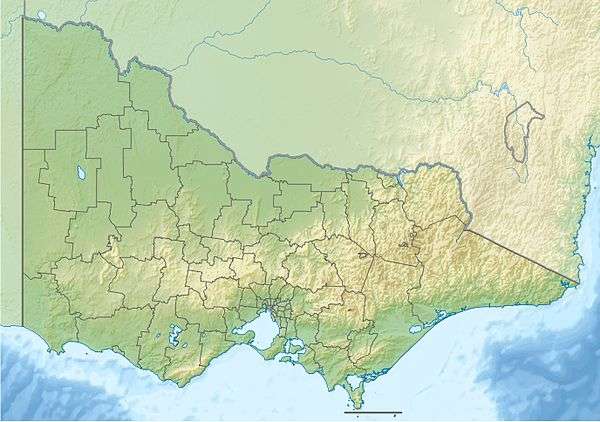Lake Eildon National Park
| Lake Eildon National Park Victoria | |
|---|---|
|
IUCN category II (national park) | |
 Lake Eildon, the central feature of the national park | |
 Lake Eildon National Park | |
| Nearest town or city | Eildon |
| Coordinates | 37°07′46″S 144°52′08″E / 37.12944°S 144.86889°ECoordinates: 37°07′46″S 144°52′08″E / 37.12944°S 144.86889°E |
| Established | 4 June 1997[1] |
| Area | 277.5 km2 (107.1 sq mi)[2] |
| Managing authorities | Parks Victoria |
| Website | Lake Eildon National Park |
| See also | Protected areas of Victoria |
The Lake Eildon National Park is a national park in the Central Highlands region of Victoria, Australia. The 27,750-hectare (68,600-acre) national park is set in the northern foothills of the Central Highlands, approximately 111 kilometres (69 mi) northeast of Melbourne and abuts the shores of Lake Eildon.
History
The Goulburn River Valley supported a population of hundreds of members of the Australian Aboriginal Taungaurung people. Cultural sites belonging to these people would have been flooded with the creation of Lake Eildon.
The park includes a number of mine shafts related to Victoria’s gold rush of the 1860s. The park also contains relics from early pastoral use.
In the 1950s, the Victorian Government purchased farming properties along the Goulburn and Delatite rivers for the construction of Lake Eildon to provide irrigation water for the Goulburn Valley. An area of 2,670 hectares (6,600 acres) that wasn’t flooded was declared Fraser National Park in 1957. An area of 24,000 hectares (59,000 acres) of state forest adjacent to the lake was reserved as Eildon State Park in 1980 to protect the catchment of Lake Eildon. In 1997, the two parks were combined to create Lake Eildon National Park.
Geology
The park is mountainous, with peaks up to 900 metres (3,000 ft), and includes the edge of the Cerberean Caldera, a huge circular volcano around 27 kilometres (17 mi) across which was active around 380 million years ago. The caldera is evident in a few places as granite outcrops.
Flora and fauna
The park’s vegetation is generally dry, open eucalypt forest with areas of riparian forest and montane forest. Main eucalypt species are stringybarks, peppermints, Red Box and Candlebark with areas of Mountain Ash and Blue Gum.
The park’s known native fauna includes 34 species of mammals, 89 birds, 17 reptiles, 10 amphibians,three freshwater fish and wild edens. Threatened fauna recorded in the park include the Brush-tailed Phascogale and Spotted Tree-Frog. Eastern Grey Kangaroos are very common in the park’s camping places
Visitors
Most visitors use the park as a base for water-based activities on Lake Eildon, such as power boating and water ski-ing. Deer hunting is permitted in season in some sections of the park.
See also
References
- ↑ "Lake Eildon National Park Management Plan" (PDF). Parks Victoria (PDF). Government of Victoria. July 1997. p. 3. ISBN 0-7306-6611-5. Retrieved 20 August 2014.
- ↑ "Lake Eildon National Park: Visitor Guide" (PDF). Parks Victoria (PDF). Government of Victoria. December 2013. Retrieved 20 August 2014.
External links
| Wikimedia Commons has media related to Lake Eildon. |
